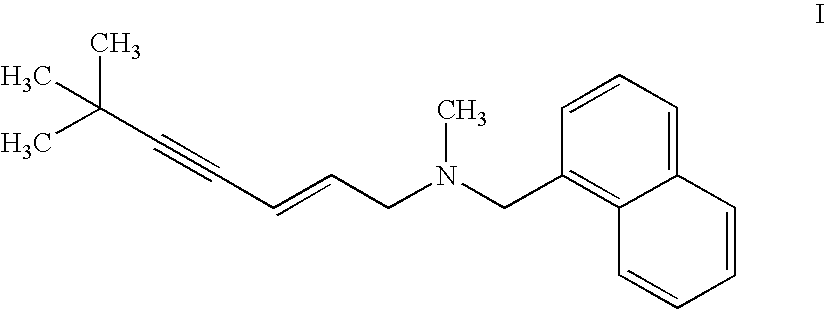Methods of administering topical antifungal formulations for the treatment of fungal infections
a topical formulation and antifungal technology, applied in the field of topical formulations of an antifungal, can solve the problems of nail bed shrinkage, nail bed dislocation, nail bed splitting, etc., and achieve the effect of preventing onychomycosis and reducing side effects
- Summary
- Abstract
- Description
- Claims
- Application Information
AI Technical Summary
Benefits of technology
Problems solved by technology
Method used
Image
Examples
example 1
5.1 Example 1
Antifungal Formulations
[0213]Antifungal formulations for topical application may be prepared by the following procedure:
1. Organic Phase Production, which Contains all Lipophilic Excipients
[0214]The organic phase is produced by weighing the lipid, the surfactant, antifungal hydrochloride and any additional lipophilic excipients into suitable containers followed by mixing these components into anoptically isotropic phase which appears as a clear solution. During mixing, the organic phase will be heated up, but temperature must not rise above 45° C.
2. Aqueous Phase Production
[0215]The aqueous phase is prepared by weighing the non-lipophilic components and water, which serves as solvent, into suitable containers and then mixing these components into a clear solution. During mixing, the temperature will be elevated to 40° C.
3. Production of a Concentrated Intermediate by Combination of Both Phases
[0216]The isotropic organic phase and the clear aqueous phase are combined und...
example formulation 1
[0220]Formulation 1 comprises antifungal (10 mg / g), sphingomyelin (brain) (47.944 mg / g) as a lipid, Tween 80 (42.056 mg / g) as a surfactant, lactate buffer (pH 4), benzyl alcohol (5.250 mg / g) as an antimicrobial agent, BHT (0.200 mg / g) and sodium metabisulfite (0.0500 mg / g) as antioxidants, glycerol (30.000 mg / g), EDTA (3.000 mg / g) as a chelating agent, and ethanol (30.000 mg / g).
example formulation 2
[0221]Formulation 2 comprises antifungal (15 mg / g), sphingomyelin (brain) (53.750 mg / g) as a lipid, Tween 80 (31.250 mg / g) as a surfactant, lactate (pH 4) buffer, benzyl alcohol (5.250 mg / g) as an antimicrobial agent, BHT (0.200 mg / g) and sodium metabisulfite (0.500 mg / g) as antioxidants, glycerol (30.000 mg / g), EDTA (3.000 mg / g) as a chelating agent, and ethanol (15.000 mg / g).
PUM
| Property | Measurement | Unit |
|---|---|---|
| concentration | aaaaa | aaaaa |
| concentration | aaaaa | aaaaa |
| concentration | aaaaa | aaaaa |
Abstract
Description
Claims
Application Information
 Login to View More
Login to View More - R&D
- Intellectual Property
- Life Sciences
- Materials
- Tech Scout
- Unparalleled Data Quality
- Higher Quality Content
- 60% Fewer Hallucinations
Browse by: Latest US Patents, China's latest patents, Technical Efficacy Thesaurus, Application Domain, Technology Topic, Popular Technical Reports.
© 2025 PatSnap. All rights reserved.Legal|Privacy policy|Modern Slavery Act Transparency Statement|Sitemap|About US| Contact US: help@patsnap.com



